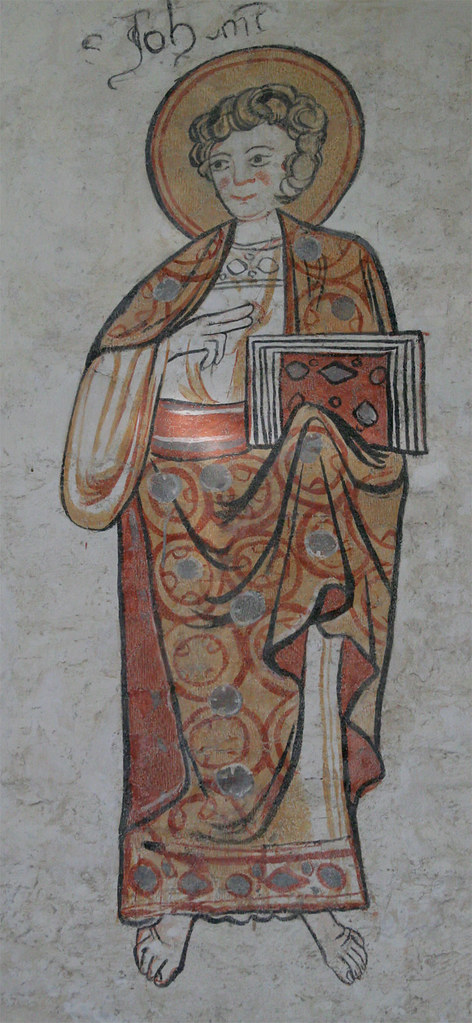Here are a selection of some western high and late medieval images of St John the Evangelist linked to by John Dillon in a post for today's feast on the Medieval Religion discussion group.
From the late twelfth-century portal (between 1180 and 1190; restored between 1988 and 1995) of the église primatiale Saint-Trophime in Arles
The series of panels early thirteenth-century Life of St. John the Evangelist window (bay 22; c. 1215) in the cathédrale Saint-Étienne in Bourges can be viewed at http://www.medievalart.org.uk/bourges/22_pages/Bourges_Bay_22_key.htm
St John portrayed in a statuette (second from left, starting with the BVM around the corner) in the earlier thirteenth century Mary Shrine (consecrated, 1239) in the cathedral treasury in Aachen

St John as depicted in a later thirteenth-century wall painting in the Reformed Church, Csaroda (Szabolcs-Szatmár-Bereg), Hungary
A detail of the painting:
St John portrayed in a silver gilt statuette on the later thirteenth-century copper gilt châsse of St. Remaclus (completed between 1263 and 1268) in the église Saint-Sébastien in Stavelot
A fourteenth-century wall painting in All Saints Church, Weston Longville (Norfolk)
Only the upper part of this painting of St. John the Evangelist is now left on the south side beside the chancel arch at Weston Longville. In the corresponding position at the north side is John the Baptist, who is very faint now.
The painting has been restored, but St. John was probably always an impressive figure. He is shown here holding the most interesting of his attributes, a poisoned cup or chalice. According to his legend, John was ordered to drink from the cup as a test of his faith by the High Priest of Diana at Ephesus. Two condemned prisoners had already done so and died. John drank and survived unharmed, further demonstrating his power by restoring the two poisoned men to life. More often than not in painted versions of the story, a serpent or small dragon is shown emerging from the cup, to make the meaning intelligible. Here indeed is a small dragon, apparently uttering a cry of despair or frustration, although it has to be said that it looks more endearing than malevolent. Some of that may be due to restoration, but the creature does not look anything like so sinister as many others I have seen, particularly in paintings of St. John on East Anglian screens. A change in sensibilities since the Middle Ages is probably also operating - the whole painting has an slight but inescapable cartoonish air. [Extract from the website below]

A fourteenth-century panel from a glass window from the château of Rouen now in the Musée National du Moyen Age (Musée de Cluny) in Paris
:

St John on Patmos by Giotto di Bondone in an earlier fourteenth-century fresco in the Peruzzi chapel of the basilica di Santa Croce in Florence
Giotto di Bondone in an earlier fourteenth-century panel painting (between 1320 and 1325) in the Musée Jacquemart-André in Paris
St John depicted by Simone Martini in a panel painting from between 1330 and 1339 in the Barber Institute of Fine Arts in Birmingham
St John drinking from the poisoned cup
St John being taken up to Heaven
St John in a later fourteenth-century vault fresco in the baptistery of Parma:
Marble statue of St John by Donatello of 1410-1411 in the Museo dell'Opera del Duomo in Florence

St John on Patmos in the earlier fifteenth-century Très Riches Heures du Duc de Berry between 1412 and 1416: Chantilly, Musée Condé, ms. 65
St John depicted by Jan van Eyck in a panel of his Ghent Altarpiece of 1432 in the cathedral of Saint-Bavon / Sint Baaf in Gand / Ghent
St John by Andrea del Castagno in his vault fresco of 1442 in the cappella di San Tarasio in Venice's chiesa di San Zaccaria

St John on the right, and on the left his brother St. James the Great, by Miguel Ximénez and workshop in a panel of his and Martín Bernad's late fifteenth-century altarpiece of the Holy Cross completed in,1487 for the parish church of Blesa (Teruel) and now, after dismemberment, mostly in the Museo de Zaragoza

St John portrayed by Tilman Riemenschneider in a limewood statue of 1490-1492 from the predella of the high altar of the St. Magdalenenkirche in Münnerstadt) and now in the Bode-Museum in Berlin
A close-up:

No comments:
Post a Comment